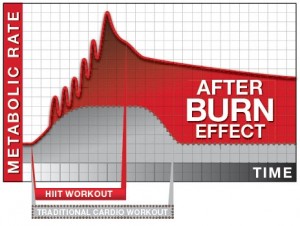By Kyle Shneider, CSCS
Stop doing cardio!
Well, stop doing the cardio that you are so used to doing and give HIIT a try.
In the traditional sense, cardio involves walking, running, biking, etc. for an elongated period of time (usually 30+ minutes) or distance at a constant moderate intensity. I can guarantee that this is what most of you reading this article choose as your go-to workout or cardio session. Unfortunately, this type of cardio, known as steady-state cardio, is holding your body back from reaching its maximum potential.
Steady-state cardio falls under the category of aerobic exercise, which ultimately trains the body to use the least amount of oxygen and energy to perform the greatest amount of work possible. In other words, steady-state cardio trains exercise efficiency. This is not the goal when you want to lose fat or build muscle. Since the body quickly adapts to this type of exercise, unless you are continually increasing distance, increasing intensity, and decreasing the amount of food you eat, steady-state cardio is unlikely to induce the noticeable fat loss you desire. Even more, favoring low to moderate-intensity aerobic exercise over long periods of time (years, not months so don’t worry too much) can lead to the loss of muscle mass and the ability to burn fewer calories by significantly lowering your resting metabolic rate (RMR).
The fix: High intensity interval training, or HIIT.
On the other hand, HIIT places a great deal of metabolic stress on the body, which is exactly what you want when fat loss and a toned physique are your goals. HIIT describes any workout that alternates between intense bursts of activity and periods of less intense activity or even complete rest. Metabolic disturbance is the key, and these bursts of all-out, intense activity are what make HIIT so effective as a fat burner. In fact, you can actually burn just as many calories doing 20-30 minutes of HIIT as you will doing 45-60 minutes of steady-state cardio.
 Now, this is what seals the deal: Unlike steady-state cardio, the overwhelming metabolic stress placed on your body during successfully executed HIIT boosts your RMR and fat burning enzymes so much that fat burning continues even after your workout is over! Results from a 2006 study conducted by Florida State University indicate that HIIT burns almost 10% more calories during the 24 hours following exercise as compared to steady-state exercise, even when the total amount of calories expended during the workouts are identical. But, not only does HIIT lead to greater fat loss than low to moderate-intensity steady-state training, it also maintains and possibly increases muscle mass by stimulating the release of important anabolic hormones.
Now, this is what seals the deal: Unlike steady-state cardio, the overwhelming metabolic stress placed on your body during successfully executed HIIT boosts your RMR and fat burning enzymes so much that fat burning continues even after your workout is over! Results from a 2006 study conducted by Florida State University indicate that HIIT burns almost 10% more calories during the 24 hours following exercise as compared to steady-state exercise, even when the total amount of calories expended during the workouts are identical. But, not only does HIIT lead to greater fat loss than low to moderate-intensity steady-state training, it also maintains and possibly increases muscle mass by stimulating the release of important anabolic hormones.
The best thing about HIIT is that it can be done in any setting, eliminating the need for gym cardio equipment. HIIT can be done using a jump rope, with weights, with strength bands, and even with your own body weight. Just make sure that you are alternating extreme bouts of all-out, intense activity with short low-intensity rest “breaks.” And, most importantly, you must make sure that you are consistently pushing yourself to your limit during the intense activity intervals. By failing to do so, you will be minimizing the beneficial effects of HIIT.
From Poliquin Group, here are some great ways of incorporating HIIT into your workout regimen:
- Cycle sprints of 8-seconds all-out and 12-seconds rest repeated 60 times for a total of 20 minutes (ideal for beginners)
- Short sprint workouts of 8 to 10 reps of 200 meters (30 seconds all-out) with 1-minute active recovery
- Longer sprint workouts of 4 to 6 reps of 1:30 fast with 3-minutes active recovery
- Wingate sprints on a cycle ergometer of 4 to 6 reps of 30-seconds all-out with 3 to 4 minutes recovery
- Descending sprints of 400, 300, 200, 100 meters with 4-minutes rest after the first sprint, 3 minutes after the second, and 2 minutes after the third. Then rest 4 minutes and repeat.
- Circuit training with 10 reps per set and 10-second rest between exercises for a total of 25 to 30 minutes. For example, do squats, deadlifts, chest press, and pull down with 75% of your 1RM for 3 to 4 sets each.
- Tabata intervals in which you pick loaded or body weight exercises (depending on your conditioning) and do 20 seconds of work followed by 10-seconds rest for 4 rounds (4 minutes)
- Combat workouts: Four, 35-second all-out sprints with 10-seconds rest. Rest for 3 to 4 minutes between sets and repeat 3 or 4 times
If you’re up for this scientifically proven approach to cardio and are prepared to work extremely hard then I definitely suggest you cut back on steady-state cardio and try out some HIIT. As long as proper eating habits are in place, you never know, HIIT could be the missing piece in attaining the body you’ve always wanted.
References:
- Meuret, J.R., et al. A comparison of the effects of continuous aerobic, intermittent aerobic, and resistance exercise on resting metabolic rate at 12 and 21 hours post-exercise. Medicine & Science in Sports & Exercise 39(5 suppl):S247, 2007. http://diginole.lib.fsu.edu/cgi/viewcontent.cgi?article=4659&context=etd
- http://www.poliquingroup.com/ArticlesMultimedia/Articles/Article/1151/The_Truth_About_Cardio_For_Fat_Loss.aspx?lang=EN
- http://www.poliquingroup.com/Tips/tabid/130/EntryId/2235/How-To-Get-Your-Body-Ready-For-Summer-Five-Steps-To-A-Killer-Physique.aspx
- http://www.bodybuilding.com/fun/ask-the-muscle-prof-best-cardio-for-preserving-mass.html
- http://www.bodybuilding.com/fun/ultimate-8-week-hiit-for-fat-burning-program.html
 Kyle is not only the Director of Sales & Business Development at MCT Lean, but also a National Strength Conditioning Association (NSCA) Certified Strength Conditioning Specialist (CSCS). He has a B.S. degree in Movement Science from the University of Michigan, is currently working towards completing his Precision Nutrition Level 1 Certification, and plans on attaining his Master’s in Exercise Physiology in the near future. At the age of 23, Kyle has worked with and constructed training programs for top high school and Division I, II, and III male and female collegiate athletes.
Kyle is not only the Director of Sales & Business Development at MCT Lean, but also a National Strength Conditioning Association (NSCA) Certified Strength Conditioning Specialist (CSCS). He has a B.S. degree in Movement Science from the University of Michigan, is currently working towards completing his Precision Nutrition Level 1 Certification, and plans on attaining his Master’s in Exercise Physiology in the near future. At the age of 23, Kyle has worked with and constructed training programs for top high school and Division I, II, and III male and female collegiate athletes.
If you have any questions, want more information, need more convincing, or would like help creating a workout plan please don’t hesitate to email me at kyle@mctlean.com!



